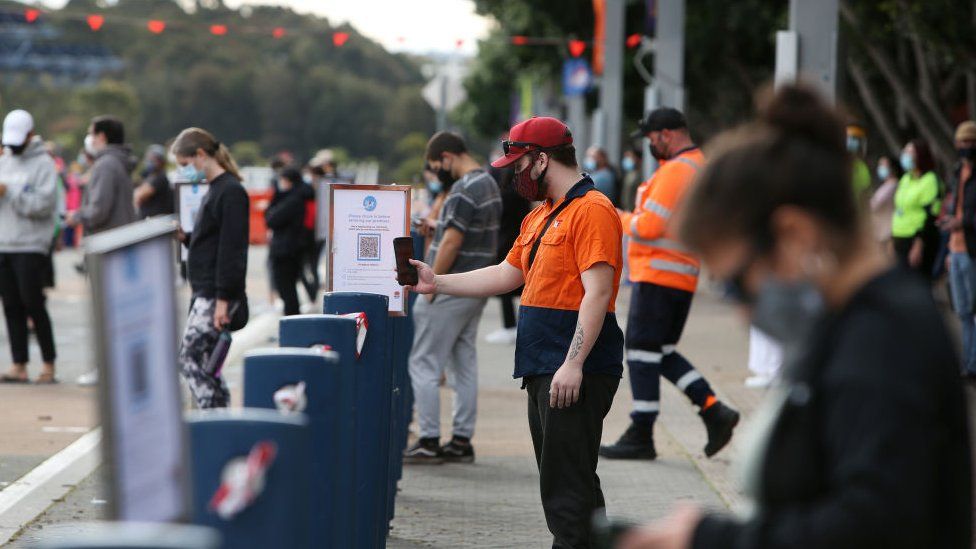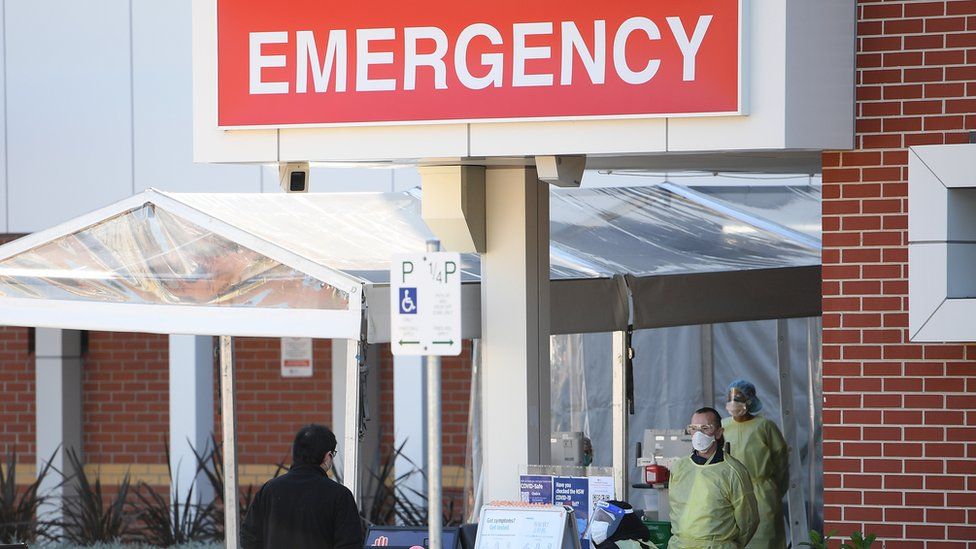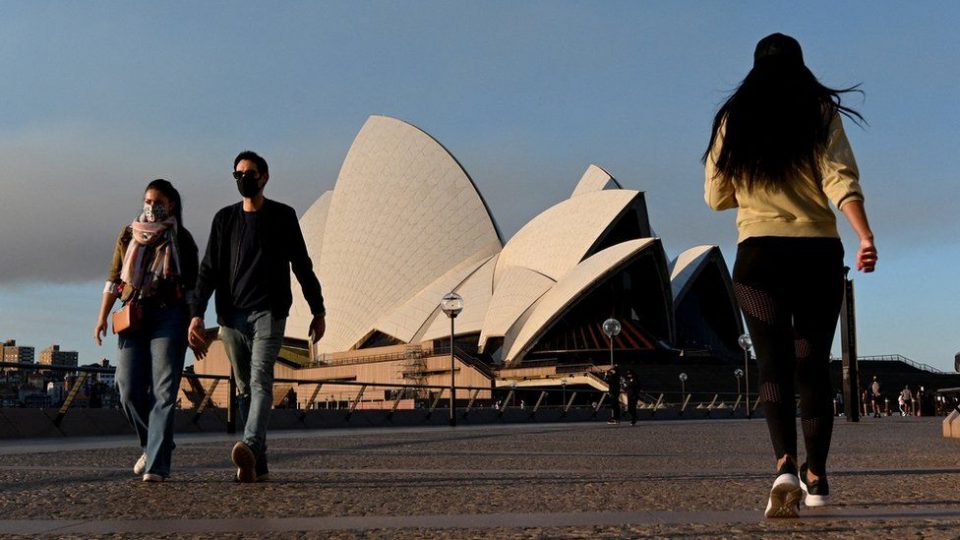Australia has changed its Covid strategy: it’s time to leave lockdowns and “come out of the cave”, Prime Minister Scott Morrison has said.
With vaccinations accelerating, he says Australians will soon “live with the virus” for the first time – that is, not try to eliminate it.
It’s a drastic shift for a country used to seeing very few infections.
What was the strategy?
It was what some dubbed the “Fortress Australia” plan.
Australia aimed to maintain “Covid zero” by blocking foreign arrivals, hunting for every infection, and shutting state borders after outbreaks.
City and state-wide lockdowns have been frequently enacted – sometimes after a single case.
Melbourne, for example, has lived through over 200 days of lockdown in the last two years.
Such measures have drawn criticism for their cost to people’s livelihoods and mental wellbeing.
But, until now, they have quelled outbreaks and allowed many Australians to live freely.
So what changed?
The Delta variant upended Australia’s playbook. In June, it took hold in Sydney before spreading to Melbourne and Canberra.
State governments plunged their capitals back into lockdown. Currently, one in two Australians must stay home.
It has helped to suppress the spread. In Sydney, the R number – the rate at which the virus is spreading – has dropped from 5 to 1.3.
But authorities have said Covid zero is no longer achievable.
That’s intensified criticism on the Morrison government over Australia’s low vaccination levels, with many accusing it of complacency. Mr Morrison had in April claimed vaccinating was “not a race”.
But he has now followed the New South Wales state government in saying that vaccinations are Australia’s only path to reopening. Victoria – which includes Melbourne – has this week also abandoned Covid zero.
So what’s the new plan?
About 36% of Australians over 16 are fully vaccinated – far from enough to exit lockdowns, experts say.
“This groundhog day has to end, and it will end when we start getting to 70% and 80%,” Mr Morrison said last week.
But Australia is picking up pace – it is now jabbing arms faster than the UK and US did at their peaks.
At current rates, Australia could vaccinate 70% of its over-16s by mid-October.
The nation has also begun vaccinating children over 12.
 Image source, Getty Images
Image source, Getty ImagesThe nation plans to ease out of lockdowns then, and vaccinated people will be granted more freedoms.
But it will continue testing and tracing, and retain low-level restrictions like mask-wearing and social distancing. Smaller lockdowns will also be a possibility but are considered unlikely.
“The plan that is proposed is actually very thoughtful and careful,” says Prof Ivo Mueller, a population health and immunity expert from the Walter and Eliza Hall Institute in Melbourne.
“It’s not ‘Freedom Day’, it’s not ‘let’s throw everything out the window and go party’ – that’s not what’s being proposed.”
When will international borders open?
That will happen when Australia hits the 80% threshold. But travel will be open to designated “safe” countries only, and to people who are vaccinated.
NSW Premier Gladys Berejiklian has said she’s aiming for a November reopening, but some experts say it could happen sooner.
“At 80% double dosage, we anticipate allowing our citizens to access international travel and also to welcoming home Australians through Sydney Airport,” Ms Berejiklian said this week.
The national plan also allows for “travel bubbles” to safe countries, indicating vaccinated foreign nationals will also be able to enter.
Airline Qantas has flagged re-opening routes in December to the UK, US, Singapore, Canada and Japan.
But is everyone happy?
Polling shows 62% of Australians support the government’s reopening plan.
But many Australians baulk at the idea of “living with the virus”, after being used to low infection rates.
The government’s modelling, prepared by the Doherty Institute, estimates that re-opening at 70% could lead to 13 deaths in six months – provided testing and tracing is at its peak. But that could rise to 1,500 if there are lesser health measures, the projection says.
It was only this week that Australia recorded its 1,000th Covid death, the last G20 country to do so.
So psychologically, it’s a big change in mind set, says Prof Mueller.
More than 90% of Australia’s cases have occurred around Sydney and Melbourne. But six of Australia’s eight states and territories have seen little of the virus at all.
“They basically have no transmission and no restrictions, people basically live normal lives so telling them they have to face the virus is really, really hard,” Prof Mueller says.
Political fight
So, Covid-free parts of the country disagree with the federal government and other states over strategy.
Under Australia’s federalism system, state governments have control over health, policing, and internal borders.
Queensland and Western Australia are now refusing to open their states while Sydney sees more than 1,000 infections a day.
“I just cannot understand why there are people over there saying we should deliberately infect ourselves,” Western Australia Premier Mark McGowan has said.
 Image source, EPA
Image source, EPABut Mr Morrison argues those states can’t hide from the virus forever.
“Most states in Australia need to realise that eventually they have to come off Covid zero, because it’s just not sustainable forever,” says Prof Mueller.
“You have to start preparing people for what life looks like, you have to start looking for solutions to the problem rather than just stopping at the problem.”
What can Australia learn from overseas?
Much can be gleaned from other countries about how to re-open safely and fine-tune risk, experts say.
Could social distancing be a requirement at schools, like they are in France and Mexico? With travel, could Australia adopt rapid diagnostic tests used in Europe and North America? What’s the best vaccine passport to allow movement safely?
Experts stress that Australia needs to now focus on vaccinating particularly at-risk groups, such as indigenous communities, before reopening.
They note that Australia’s reopening plan has also already been shaped by the UK and US experiences.
While Delta has driven infection waves in both nations, vaccinations are vastly reducing serious illnesses and deaths.
“That gives us reassurance that we’re on the right track with the vaccines,” says Prof Mueller.
Australia’s plan to re-open at 80% is a higher bar than the 54% in the UK, where the level of vaccination is now at about 80% of the eligible population. In Denmark, where 70% are vaccinated, almost all restrictions have been dropped.
Singapore, which hit 80% this week, is also ahead in its re-opening plans but is taking a cautious approach like Australia, keeping travel to safe nations and maintaining restrictions like mask-wearing.



